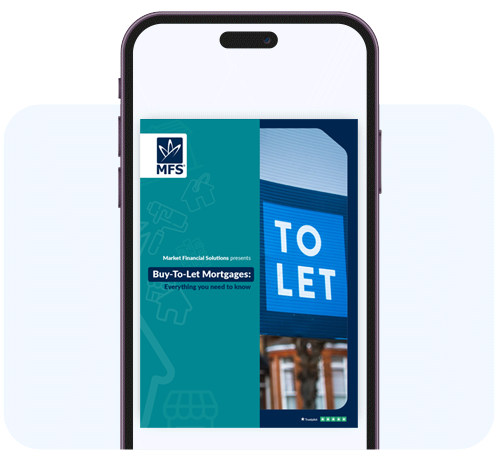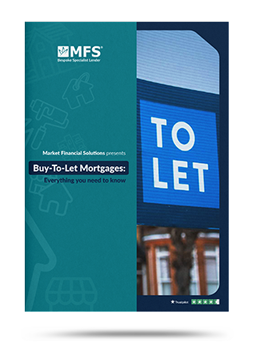- What is a Buy-to-Let mortgage explained in a comprehensive all-you-need-to-know guide
- Gain a full understanding of this mortgage type
- For brokers & direct clients
- For beginners & experts
What is a Buy-to-Let Mortgage?
A Complete Guide to BTL
Get your free Buy-to-Let Mortgage Guide below.

Introduction
This guide explains what a buy-to-let mortgage is and answers all your questions about the buy-to-let market. We will explain how specialist BTL mortgages work and what you can utilise them for. Additionally, we will explore the types of landlords who could benefit from them.
We’ll detail how our mortgages differ to those found on the high street. We’ve brought our knowledge and expertise of the bridging market with us in designing our mortgages. Meaning, you can take advantage of a BTL product that benefits from bridging like speed, flexibility, and a diverse range.
Our BTL mortgages consist of many different parts. We can tailor each one to very specific circumstances. But, we built them from the ground up with landlords in mind. This guide will clear up any questions you may have.
What is a Buy-To-Let Mortgage?
A BTL mortgage is a type of loan that allows you to purchase a property and rent out to a third party, a tenant(s). This makes you a landlord, who will use the income from your rent-paying tenants to cover the mortgage payments.
Buy-to-let mortgages have many similarities to “regular” mortgages, with a few notable differences. Some lenders consider them to be a higher risk product. That’s why the fees, interest rates, and deposits for this particular mortgage type may be relatively high. Also, BTL mortgage claimants will not be able to live in the property they’re investing in.
If you want to live in the property you’re purchasing, you’ll need a residential mortgage. You can not rent it out or use it for commercial use. BTL mortgage claimants can’t live in the property they’re investing in, but can rent it out.
You can use a buy-to-let mortgage for a range of residential properties. This includes standard houses (new-builds, maisonettes etc) and flats. However, investors may use BTL mortgages for specific property types primed for the rental market. Examples include houses in multiple occupation (HMO) which tend to be popular with students, or short-term lets for holiday seekers.
While terms and product details will vary between lenders, most BTL mortgages are interest only. Lender primarily assess affordability via an interest coverage ratio (ICR). This is the ratio of gross rental income to mortgage interest repayments. Most lenders will require an ICR of between 125% and 140% as a minimum.
You can get buy-to-let mortgages from several high street-banks, along with specialist lenders.
Types of Buy-To-Let Mortgages:
No one product fits all circumstances. That’s why we have a range of buy-to-let mortgages available. We can tailor our buy-to-let mortgage to your situation, however difficult or complex it may be. We have specific loans available for different scenarios, from complex setups, to purchasing through a limited company.
Types of Buy-To-Let Mortgages
Complex Buy-to-Let Mortgages
Complex BTL mortgages are for borrowers who may have particularly complicated backgrounds or setups. This can include a claimant’s financial history. Borrowers could also have defaults, county court judgements (CCJs), or bankruptcies to their name.
You may also need a complex BTL mortgage based on the property itself. Large properties, multi-unit freehold properties, or flats above a commercial space may all involve many moving parts and tricky complications. As such, they’ll need a mortgage designed with these complications in mind.
How you’re investing may also prove complex. You may apply via a trust or with overseas income. A complex BTL mortgage is also suitable for you if you need to complete in just a few weeks. While we can work with all of this, the complexity of the deal will require additional due diligence and care.
Types of Buy-To-Let Mortgages
Buy-to-Let Mortgages For Bad Credit
A bad credit buy-to-let mortgage is for those with missed payments and other issues. If you have bad credit, or a poor credit rating, you did not cover your bills on time in the past. This may indicate that you may struggle to make timely payments in the future.
In the UK, the three main credit rating agencies are Equifax, Experian, and TransUnion. These agencies assign borrowers a score. And while there is variation between them, generally, the lower your score, the poorer your creditworthiness.
If you have a low score, lenders may be unwilling to lend to you. Alternatively, they might only offer you their most restrictive products. Bad credit BTL mortgages may be available for these kinds of borrowers. While we assess criteria on individual merit, those with poor credit ratings may face higher costs, reflecting the risk involved.
Types of Buy-To-Let Mortgages
Limited Company & SPV Buy-to-Let Mortgages
Limited company and special purpose vehicle (SPV) BTL mortgages are for borrowers investing in property via a corporate setup, rather than as an individual. This may be an attempt to take advantage of certain tax incentives or other perks.
At Market Financial Solutions, we are able to lend to a range of corporate bodies. Those include the aforementioned options, as well as LLPs, trading companies, offshore entities and more. We assess our limited company and SPV BTL mortgages similarly to our loans for individuals, or groups of individuals.
But, we may place additional due diligence on your corporate situations. For instance, we will likely require specific details on any directors or shareholders involved. There may also be limitations for shareholders who own less than 20% of the total shares.
While corporate borrowers may present additional layers, we’re happy to hear from property investors from all backgrounds. Just as is the case with individual borrowers, we assess all our corporate deals on their individual merits.
Types of Buy-To-Let Mortgages
Foreign National & Expat Buy-to-Let Mortgages
A foreign national & expat buy-to-let mortgage is for property investors investing from overseas. Our mortgages are available to property investors from any country, except sanctioned ones. Expats, foreign nationals, and/or offshore companies can use our BTL mortgages to invest in English or Welsh property.
Our BTL mortgages are just as available to foreign national landlords as they are domestic buyers. However, where investors have a limited footprint in the UK, we require enhanced due diligence. We will assess your history in the UK, and abroad where needed.
Specialist BTL mortgages for foreign nationals support investors gaining easier access to the UK market. With high street banks, there may be additional red-tape or barriers to entry. But, we have no issues working with overseas interests and can issue funding quickly where everything lines up.
Types of Buy-To-Let Mortgages
Commercial Buy-to-Let Mortgages
Commercial buy-to-let mortgages can cover two separate scenarios. This includes BTL mortgages for those investing in residential property through a corporate set up, or as a business. Then there are buy-to-let mortgages for commercial properties, such as offices or retail stores. In both scenarios, investors might handle more substantial portfolios when compared to individual landlords or first-time buyers.
As with all our products, our commercial mortgage processes can adapt to a range of complications. For corporate borrowers, this may include individual voluntary arrangements (IVAs), tax issues, bankruptcies and more. Some buy-to-let mortgage claims may require a cashflow statement, or business plan where the operations are particularly complex.
Types of Buy-To-Let Mortgages
First-Time Buyer BTL Mortgage
First-time buyer BTL mortgages for buyers making their very first investment in the property market. This includes first time landlords, along with first time commercial landlords or owner-occupiers. These mortgages factor in the potential limitations that first-time buyers present.
For instance, our first-time BTL mortgages takes into account that the borrower has no experience in the property market. Or that they may not be familiar with the investment process. Our teams will work with first-time buyers to support them throughout the application, and guide them through the process.
You can utilise our first-time buyer mortgage for any property type that falls under our remit. Though, first-time buyers are likely to start out with the more streamlined investments like single residential flats or new builds.
Types of Buy-To-Let Mortgages
HMO Buy-To-Let mortgages
An HMO mortgage is for investments in House in multiple occupation properties. A property will count as a HMO if it has at least 3 tenants living in it, forming more than 1 household, and they share a toilet, bathroom, and kitchen.
Your investment would be a large HMO if it’s for 5 tenants living together and sharing facilities. At Market Financial Solutions, we offer BTL mortgages for HMOs with no room limits. Typically, HMOs are rented out to students, but they’re also available for a range of tenants willing to share space.
This can include house shares for young professionals, certain state benefit claimants, or even families. Landlords of large HMOs need to meet certain standards and obligations, and may need a license. Where required, we may need to see a local authority license during the underwriting process.
Types of Buy-To-Let Mortgages
Self-Employed Buy-To-Let Mortgages
A self-employed buy-to-let mortgage is for those who work for themselves. You are self-employed if you run a business for yourself and are responsible for its success or failure. Being self-employed is different to operating a limited company, which is a separate legal entity from its owners.
If you’re a self-employed worker, your income may be sporadic, perhaps even seasonal. Our self-employed BTL mortgages can take these kinds of elements into account. You need a minimum income of £30k per year from your self-employed work, other employment income, or private pension.
Across all our BTL mortgages, the loans have 4 different tiers. Tiers 1 and 2 are for simple and straightforward cases – investments in standard buy-to-let properties via simple setups. Tiers 3 and 4 are for the more complex deals – such as those involving large structures and foreign nationals. The more complicated or risky your situation, the higher the tier you’ll fall into.
Types of Buy-To-Let Mortgages
Remortgage
Across all our BTL products, it is possible to remortgage. You can also remortgage onto one of our products from a different lender. You can also apply for another flexible BTL mortgage from Market Financial Solutions where needed.
What’s more, it’s also possible to remortgage from one of our BTL products onto a bridging loan. We offer a range of specialist finance options which can support your long-term rental investment goals. For instance, we have flexible renovation and refurbishment finance available that can help get your property spruced up for new tenants.
We also have development exit loans. If you come to the end of a project, you can cover your initial development finance. Our funding can provide breathing space and freedom of choice for landlords with largescale plans.
No matter what your BTL or bridging plans may involve, you’ll get a dedicated underwriter from day 1. They will answer any questions you may have, support your long-term vision, and facilitate finance where possible and appropriate.
“The Complete
BTL Mortgage Guide”
What is the LTV for a BTL Mortgage & how much deposit do I need?
Across all our BTL mortgages, we have a maximum loan-to-value (LTV) ratio of 75%. Our tier 4 mortgages, reserved for the most complex, applications, require an LTV of 70%. This means you’ll need a minimum deposit of 25% of your property’s value.
If you’re investing in a flat above a commercial property, the max LTV available will range between 60% and 70%. The type of commercial premises will affect the LTV. Your deposit will depend on you investing on-top of, or immediately adjacent to a restaurant, takeaway business, pub, or launderette.
Remember that your investment will have a dedicated underwriter. All our underwriters have the flexibility to boost loan sizes, subject to our max LTVs.
What are the buy-to-let mortgage lending criteria?
Across all our mortgages, we assess the BTL lending criteria on individual circumstance and merit. We don’t follow a tick-box criteria. How we review your claim will be different from how we assess any other claim. We will factor in your background, the exit strategy at hand, the property’s value and potential, and more.
We have a target ICR of 130%, comparing rent over an initial 2-year mortgage term to total interest payable. But, where needed, our BTL mortgage claimants can utilise tools to boost what they can afford. We can defer up to 2% interest until redemption to raise the loan size available to you. Additionally, we can roll-up 1 to 9 months of payments and offer top-slicing using surplus portfolio income. Our underwriters have extra flexibility to boost loan size even further where appropriate.
All our mortgages are available to a broad range of investors. Though we have a minimum income requirement of £30,000 for first-time landlords or buyers. However, so long as you are between 18 and 75+ year sold, we will match you to an appropriate BTL solution.
We’re able to service domestic landlords, from individual buyers through to complex business setups, as well as foreign national investors. This includes expats, offshore companies, or offshore trusts. What’s more, there is no limit on how many BTL mortgages a borrower can claim.
Can I change a Residential to a Buy-To-Let Mortgage?
Yes, it is possible to turn a residential mortgage/property into a BTL asset. You can do this through 2 main methods: you can obtain a consent to let agreement from your residential lender. Or you can remortgage onto a BTL product.
You may be able to swap your residential mortgage for a BTL product with your existing lender. Where this is not an option, you might be able to remortgage onto one of our BTL mortgages. However, we will need to ensure that your asset(s) adhere to the necessary parameters for the BTL market.
If you’re unsure of what’s possible for your situation, you can reach out to us directly. Our teams will always be happy to answer any questions you may have. They’ll be able to respond to all enquiries within 4 hours.
Can I swap from a Bridging Loan to a Buy-to-Let Mortgage?
It is possible to move onto our BTL mortgages from one of our bridging loan products. In fact, our mortgages are ideal for a bridging exit strategy.
For example, you may be able to use a residential bridging loan to acquire a property. Once you have secured the home, you may then be able to move onto one of our BTL mortgages to rent out the property and bring in rental income.
Or, you could use our permitted & light development bridging loans to refurbish an existing space. Once you have upgraded your property, and it is ready to attract new tenants, our mortgages can help take your property investment plans to the next level.
We will assess your application and long-term plans to find the right finance for your circumstances.
What is the difference between Regulated & Unregulated Buy-To-Let Mortgages?
In most cases, a BTL mortgage will be unregulated. Regulated BTL mortgages are overseen by the Financial Conduct Authority (FCA). They will likely have stricter processes in place when compared to non-regulated BTL loans.
Generally, landlords use regulated BTL mortgages when they plan to rent their asset to an immediate family member. This includes siblings, children, parents, or grandparents. There are also consumer BTL mortgages which are regulated by the Financial Conduct Authority (FCA). These tend to be for accidental landlords – those who became landlords due to circumstances outside of their control.
The vast majority of BTL mortgages are not regulated, as they are considered a business transaction. As such, they won’t qualify for the FCA’s consumer regulations. But, the BTL mortgage process can move relatively quickly as a result of being unregulated, while also being very flexible.
Fixed Rate vs. Tracker Rate
Our BTL mortgages have fixed or tracker options, each being further sub-categorised into 4 tiers. Our tier 1 initial tracker rate (2 years) is our set interest rate, plus the Bank of England base rate (BBR). The rates rise through the tiers, with all having the BBR added.
The interest rate for our fixed BTL mortgage will stay the same, regardless of any rises in the BBR. You can find the lowest rates on the tier 1 product. Rates increase through the tiers, being the highest in tier 4 due to the complexities associated with these cases.
The rates offered to you will be heavily dependent on your specific circumstances. Also, our rates and terms will be affected by the ongoing movement of the economy, and the wider lending market.
Interest-Only vs. Repayments
Your monthly repayments of your interest-only BTL mortgage will only pay the interest charges on the loan. You will not pay back the original capital borrowed at that point. This means you will need to cover the BTL mortgage in its entirety by the end of the term.
This will be your exit strategy and often, this involves refinancing onto a long-term form of finance, or selling an asset or property to cover the loan.
Monthly repayments for repayment BTL mortgages will be split into two elements. The first covers the interest owed on the original loan, while the other half goes towards reducing the mortgage amount. By the end of the term, repayment mortgage borrowers will own the property outright.
At Market Financial Solutions, we only offer interest only BTL mortgages, given their short-term nature. The repayments will need to covered via a direct debit from a UK based account.
Download Your Buy-to-Let Guide
All You Need To Know About BTL
Useful Tool:
Buy-to-let Mortgage Calculator
You won’t need to start your application from scratch, or without some pre-planning. We have a free-to-use, interactive BTL mortgage calculator available on our website. This calculator allows you to see how much you can borrow and what you will need to repay. You will also know if we are able to provide you with the BTL finance you need.
The total amount and rates applicable to your loan can vary based on a range of circumstances. Our calculator will allow you to incorporate these circumstances, set financial limits, and plan for the future.
Our calculator is easy to use and requires just a few key details on your investment. Broadly, this includes information on the property, the estimated market value of the asset(s), details on rental income you expect, the term of the mortgage you’re after, and the total amount of money you’d like to borrow in pounds sterling.
The calculator contains a mixture of multiple-choice prompts, as well as data points you’ll need to type in. As you enter the information, you’ll get a maximum gross loan figure. We’ll also show the LTV available for your situation.
The figures the calculator presents to you will be estimations on what you might be able to borrow and repay. For exact figures, you’ll need to contact our team directly to get the ball rolling.
How to apply for a Buy-to-Let mortgage & how long does it take?
To apply for one of our BTL mortgages, you’ll need to send through an initial enquiry. You can do this over the phone, online, or via email. One of our underwriters will be in touch within 4 hours to gather some initial details on your background and investment.
You can find our contact details directly on our website, and both borrowers and brokers can contact us alike. We have teams for both, and you will have the same dedicated underwriter throughout your time with us.
What’s more, we have business development managers (BDM) spread across England and Wales. They will be happy to meet up with you and discuss your details at length. You can also sign up to our newsletter to keep up with our products, latest case studies, and other developments.
What is the Buy-to-Let mortgage process?
Once we get your initial details, we can provide an indicative tier you’ll fall into. We will also provide a rate and loan size. If you’re happy to progress, we will move ahead with the underwriting.
We will issue a decision in principle (DIP) verified by our internal Credit Committee, usually within 24 hours. You will then sign the DIP and cover the valuation and admin fees. We will then complete the valuation. Again, we instruct this within 24 hours of fees being cleared.
As we reach the final stages, the solicitors involved will issue contracts and get everything wrapped up their end. We only use legal firms we know and trust at Market Financial Solutions. Once everything is good to go, we will provide the funding for its intended use. You could have the funds in as little as a week from your initial enquiry.
Beyond the Mortgage application…
You will then need to get on with the job of being a landlord. This means finding tenants for your BTL property. Ultimately, you will have freedom over how much rent you charge. But you will need to consider the average rents for your area, what your tenants can afford, and other economic factors.
Ideally, your rental income covers your mortgage repayments and other costs, but also provides you with a decent yield. A rental yield is the potential return on property investment through rent. A net rental yield or “true yield”, will show what you’ll get after you factor in the costs.
Typically, these costs will include the mortgage, insurances, upkeep and more. Say you invest in a property with a value of £300,000. The calculation for net rental yield is as follows: £30,000 (yearly income from rent), – £10,000 (annual costs), = £20,000.
This £20,000 is your net rental income. You’ll then need to take the net rental income figure, divide it by the property value, and times the result by 100 to get the net rental yield. So, for this example, the net rental yield is: £20,000 / £300,000 x 100 = 6.6%.
Is a Buy-to-Let mortgage broker necessary?
It is possible for borrowers to apply for a BTL mortgage directly. Though property investors may find it easier utilising a mortgage broker. There are many reasons for this.
Generally, a broker will be able to help you navigate the mortgage landscape. They tend to have advanced market knowledge and access to products that may not be available for direct clients. They can also find mortgage solutions that fit in with your specific circumstances.
Brokers tend to have relationships with the lenders they work with. This may enable their borrowers to take advantage of special deals and/or rates.
At Market Financial Solutions, given the specialist nature of our industry, we primarily work with brokers. We are always open to welcoming new brokers into our network. New brokers/intermediaries can register with us directly on our website.
Buy-to-Let mortgage tax relief & stamp duty
Prior to April 2020, landlords could benefit from BTL mortgage interest tax relief. This meant they could claim tax relief on their mortgage interest payments at their marginal rate of tax. As such, claims of up to 45% were possible.
While this relief is no longer available, there are still many tax perks BTL investors can utilise. Currently, tax credits are available to landlords, and first-time buyers can utilise stamp duty relief. Landlords may also be able offset certain expenses against their tax bill, such as utility costs and letting agent fees.
Investing through a limited company may also present landlords with certain tax perks. The rules around tax can be complicated however. We recommend to seek guidance from qualified accountants and financial planners.
BTL Industry: In Focus
“Demand for rental property continues to outpace supply. There are believed to be 10 prospective tenants registering per available property.” (Office for National Statistics)
“Private rental prices paid by tenants in the UK rose by 4.9% in the 12 months to March 2023, up from 4.8% in the 12 months to February 2023.” (Office for National Statistics)
“Within England, the East Midlands saw the highest annual percentage change in private rental prices in the 12 months to March 2023 (5.1%).“ (Office for National Statistics)
“Annual private rental prices increased by 4.6% in England, and 4.4% in Wales.” (Office for National Statistics)
“There are currently BTL 60,000 businesses operating in the sector, marking an annual increase of 2.1% and five-year growth of 12.8%.” (Property Reporter)
“The average rents for new lets have risen by 11.1 per cent compared to last year. Zoopla figures show that earnings have increased by 6.7 per cent compared to last year.” (Mortgage Solutions)
“Overall buy-to-let product availability – fixed and variable – has improved month-on-month, returning to levels not seen since August 2022 (2,375), according to the latest analysis by Moneyfacts.co.uk. There are now 2,400 options available, the highest count since July 2022 (2,746).” (Property Industry Eye)
“Across England and Wales, rental yields have seen both annual and quarterly increases up from 6% a year ago, and 6.4% in the last quarter of 2022 to 6.5% now, according to new data.” (Property Reporter)
Case Study 1
We pride ourselves on our ability to provide bridging like speed to the BTL mortgage market. This is the case for domestic buyers and foreign national landlords alike. A good example of this occurred in this deal where we supported a returning offshore borrower facing up against tight deadlines.
The client wanted to purchase a new build property, with the intention of letting it out to tenants. But, they were under pressure from the developers involved to wrap everything up quickly. As such, the client needed flexible and rapid finance.
To move quickly, we assessed the property’s long-term potential. We reviewed everything from its location, through to the type of tenants it could attract.
While there were initial issues concerning the property’s rental yield, our underwriter considered the larger picture, looking at the wider market’s health. We were able to deliver funding that met the developer’s deadlines.

Case Study 2
We regularly work with investors focusing on the long-term. But we can also appreciate the short-term elements of the BTL market. We supported a borrower looking to invest in an Airbnb property that needed some repair work. The residential assets’ value was heavily dependent on the holiday season, which we factored in when assessing the loan’s feasability.
We had to make sure the loan stood on solid foundations. That’s why our underwriter assessed the client’s background and the property involved to limit any potential downsides. The valuer confirmed the general condition of the building was solid, even with required repair work. This, coupled with the client’s vast letting experience, made us comfortable in delivering finance.

Case Study 3
Even where an investors background is less-than-ideal, we can offer support. A borrower, with an adverse credit history turned to us for support.
We explored the client’s background and discovered their credit record had been clean for some time. We also saw that they had other investment properties in their portfolio. This reassured us their finances sat on solid foundations, and we were happy to lend.

Conclusion
Across all our Buy-to-Let mortgage deals, we vow to put the interests of individual and portfolio landlords first. Wherever possible, we will do what we can to provide specialist mortgages for landlords. It doesn’t matter to us whether you’re making your first steps into the market, or expanding a portfolio you’ve managed for decades.
Our flexibility stretches across backgrounds and circumstances. We can work with the standard deals for single apartments. Moreover, we are expert in complicated cases that are likely to face pushback from mainstream providers. Though, we relish a challenge – we’re happy to hear from foreign national buyers, investing through a trust, or a holiday-let property situated on top of a pub!
We will never dismiss a claim before we have a chance to look over the details. We look for reasons to lend, no matter what complications present themselves. Our underwriters are here for you at every step of the process, and they have dealt with every property variable imaginable. If you’re worried that your specific situation is too much to deal with, we’re here to simplify things.
Market Financial Solutions are a bridging loan and buy-to-let mortgage provider and are not legal, financial, investment or tax advisers. This document is for informational purposes only and does not, and should not be considered, to constitute legal, financial, investment or tax advice or be relied upon by any person to make a legal, financial, investment or tax decision. Therefore, Investors are encouraged to seek appropriate professional advice. The information in this content is correct at time of writing.

The Complete Guide to
Buy-to-Let Mortgages
Everything you need to know
- Fundamentals
- Different mortgage types
- Useful tools
- Industry stats & more
